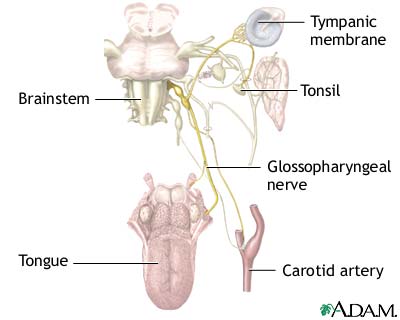Health Library
Glossopharyngeal neuralgia
Cranial mononeuropathy IX; Weisenberg syndrome; GPN
Glossopharyngeal neuralgia (GPN) is a rare condition in which there are repeated episodes of severe pain in the tongue, throat, ear, and tonsils. The pain can last from a few seconds to a few minutes.
Images

I Would Like to Learn About:
Causes
GPN is believed to be caused by irritation of the ninth cranial nerve, called the glossopharyngeal nerve. Symptoms usually begin in people over age 50.
In most cases, the source of irritation is never found. Possible causes for this type of nerve pain (neuralgia) are:
- Blood vessels pressing on the glossopharyngeal nerve
- Growths at the base of the skull pressing on the glossopharyngeal nerve
- Tumors or infections of the throat and mouth pressing on the glossopharyngeal nerve
Symptoms
The pain usually occurs on one side of the head and may be jabbing. In rare cases, both sides are involved. Symptoms include severe pain in areas connected to the ninth cranial nerve:
- Back of the nose and throat (nasopharynx)
- Back of the tongue
- Ear
- Throat
- Tonsil area
- Voice box (larynx)
The pain occurs in episodes and may be severe. The episodes can occur many times each day and awaken the person from sleep. It can sometimes be triggered by:
- Chewing
- Coughing
- Laughing
- Speaking
- Swallowing
- Yawning
- Sneezing
- Cold beverages
- Touching (a blunt object to the tonsil of the affected side)
Exams and Tests
Tests will be done to identify problems, such as tumors, at the base of the skull. Tests may include:
- Blood tests to rule out any infection or tumor
- CT scan of the head
- MRI of the head
- X-rays of the head or neck
Sometimes the MRI may show swelling (inflammation) of the glossopharyngeal nerve.
To find out whether a blood vessel is pressing on the nerve, pictures of the brain arteries may be taken using:
- Magnetic resonance angiography (MRA)
- CT angiogram
- X-rays of the arteries with a dye (conventional angiography)
Treatment
The goal of treatment is to control pain. The most effective medicines are antiseizure medicines such as carbamazepine. Antidepressants may help certain people.
In severe cases, when pain is difficult to treat, surgery to take pressure off the glossopharyngeal nerve may be needed. This is called microvascular decompression. The nerve can also be cut (rhizotomy). Both surgeries are effective. If a cause of the neuralgia is found, treatment should control the underlying problem.
Outlook (Prognosis)
How well you do depends on the cause of the problem and the effectiveness of the first treatment. Surgery is considered effective for people who do not benefit from medicines.
Possible Complications
Complications of GPN may include:
- Slow pulse and fainting may occur when pain is severe
- Damage to the carotid artery or internal jugular vein due to injuries, such as a stab wound, that may be associated with GPN
- Difficulty in swallowing food and speaking
- Side effects of the medicines used
When to Contact a Medical Professional
See your health care provider right away if you have symptoms of GPN.
See a pain specialist if the pain is severe, to be sure that you are aware of all your options for controlling pain.
References
Digre KB. Headaches and other head pain. In: Goldman L, Cooney KA, eds. Goldman-Cecil Medicine. 27th ed. Philadelphia, PA: Elsevier; 2024:chap 367.
Ko MW, Prasad S. Headache, facial pain, and disorders of facial sensation. In: Liu GT, Volpe NJ, Galetta SL, eds. Liu, Volpe, and Galetta's Neuro-Ophthalmology. 3rd ed. Philadelphia, PA: Elsevier; 2019:chap 19.
Miller JP, Burchiel KJ. Microvascular decompression for trigeminal neuralgia. In: Winn HR, ed. Youmans and Winn Neurological Surgery. 8th ed. Philadelphia, PA: Elsevier; 2023:chap 200.
Narouze S, Pope JE. Orofacial pain. In: Benzon HT, Raja SN, Liu SS, Fishman SM, Cohen SP, eds. Essentials of Pain Medicine. 4th ed. Philadelphia, PA: Elsevier; 2018:chap 23.
BACK TO TOPReview Date: 6/13/2024
Reviewed By: Joseph V. Campellone, MD, Department of Neurology, Cooper Medical School at Rowan University, Camden, NJ. Review provided by VeriMed Healthcare Network. Also reviewed by David C. Dugdale, MD, Medical Director, Brenda Conaway, Editorial Director, and the A.D.A.M. Editorial team.
 | A.D.A.M., Inc. is accredited by URAC, for Health Content Provider (www.urac.org). URAC's accreditation program is an independent audit to verify that A.D.A.M. follows rigorous standards of quality and accountability. A.D.A.M. is among the first to achieve this important distinction for online health information and services. Learn more about A.D.A.M.'s editorial policy, editorial process and privacy policy. A.D.A.M. is also a founding member of Hi-Ethics. This site complies with the HONcode standard for trustworthy health information: verify here. |
The information provided herein should not be used during any medical emergency or for the diagnosis or treatment of any medical condition. A licensed medical professional should be consulted for diagnosis and treatment of any and all medical conditions. Links to other sites are provided for information only -- they do not constitute endorsements of those other sites. No warranty of any kind, either expressed or implied, is made as to the accuracy, reliability, timeliness, or correctness of any translations made by a third-party service of the information provided herein into any other language. © 1997- 2025 A.D.A.M., a business unit of Ebix, Inc. Any duplication or distribution of the information contained herein is strictly prohibited.
